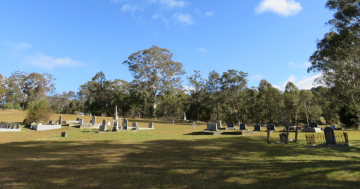
Quaama Cemetery will be the site of a community science event this month. Photo: BVSC.
What goes on at Quaama Cemetery once everyone has left?
You will be able to get an idea of what life is like in the graveyard when the next event in the popular Life in Our Cemeteries series takes place there at the end of this month.
Bega Valley Shire Council’s environmental management officer, Erin Moon, said the great amount of interest in previous events showed that people were interested in their local history, plants and wildlife.
“The fact the location is their local cemetery also makes it a unique event,” she said.
“By identifying the biodiversity at the site and detecting any changes, programs like this help to inform the future management of our shire’s cemeteries.”
Atlas of Life chairperson Raymond Daly said attendees would explore the cemetery and document what they found on the iNaturalist app so the identity of the plants, insects or animals they found could be confirmed.
Botanist Jackie Miles will talk about local vegetation, historian Fiona Firth will discuss the history of Quaama and there will be a lunchtime session on tree responses to bushfire by arborists Andrew and Rebeccah Norman.
Also, Potoroo Palace’s Anna Lindstrand and Kimberley Howard will talk about feral cat impacts and wildlife rescue while Deb Taylor will lead a walk and talk on the resident invertebrates.
“Jackie Miles tells us that like some of the other rural cemeteries in the region, Quaama Cemetery provides an insight into what the vegetation of Bega Valley’s farming areas might have been like prior to clearing for agriculture,” Mr Daly said.
“Being adjacent to Dry River, it carries a mixture of lowland grassy woodland and river-flat eucalypt forest species, both now listed as threatened ecological communities because of the extent they have been cleared and ongoing threats from weeds and farming activities.”
Ms Firth said Quaama was developed beside the ironically named Dry River by colonists in the 1870s and it was declared a village in 1887.
“The cemetery, set aside on the edge of the village, contains only a few older memorials from the early 1900s, reflecting the small population over the first half of the 20th century,” she said.
“It’s not known how many unmarked graves there are in the Quaama Cemetery but with population increasing in and around the village in the 1980s, many more burials have taken place since then.”
Atlas of Life says that full care and respect for the cemetery and those interred will be maintained during this event.
The free Life in Our Cemeteries event will take place at the Quaama Cemetery on 31 August from 11 am to 3 pm. A light lunch will be provided.
If you are interested in participating, register by clicking here.









